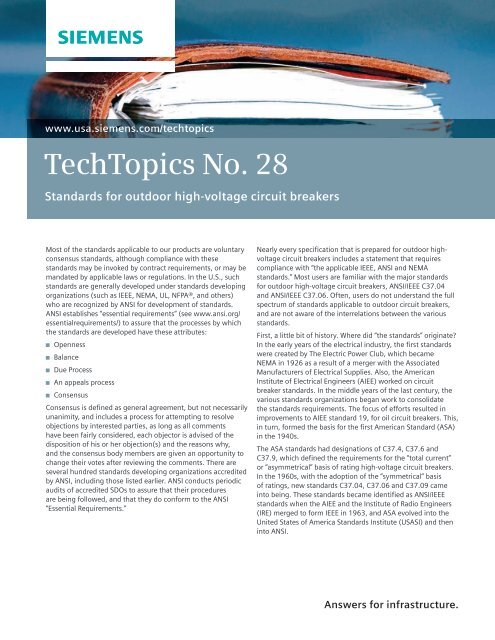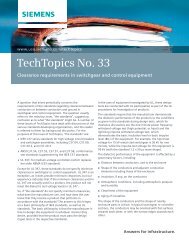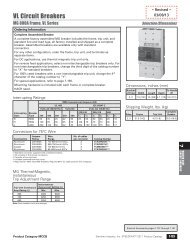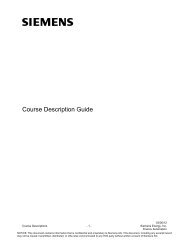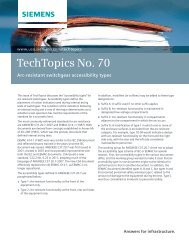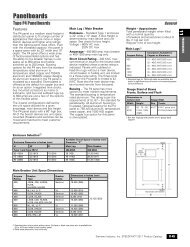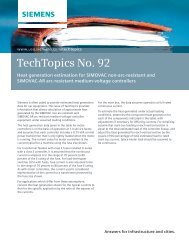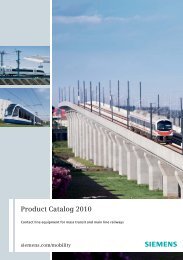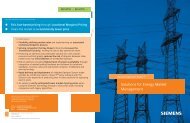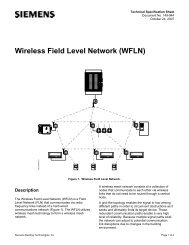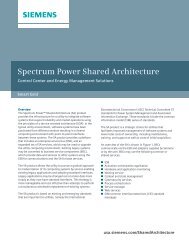TechTopics No. 28 Standards for outdoor high-voltage ... - Siemens
TechTopics No. 28 Standards for outdoor high-voltage ... - Siemens
TechTopics No. 28 Standards for outdoor high-voltage ... - Siemens
Create successful ePaper yourself
Turn your PDF publications into a flip-book with our unique Google optimized e-Paper software.
www.usa.siemens.com/techtopics<strong>TechTopics</strong> <strong>No</strong>. <strong>28</strong><strong>Standards</strong> <strong>for</strong> <strong>outdoor</strong> <strong>high</strong>-<strong>voltage</strong> circuit breakersMost of the standards applicable to our products are voluntaryconsensus standards, although compliance with thesestandards may be invoked by contract requirements, or may bemandated by applicable laws or regulations. In the U.S., suchstandards are generally developed under standards developingorganizations (such as IEEE, NEMA, UL, NFPA®, and others)who are recognized by ANSI <strong>for</strong> development of standards.ANSI establishes “essential requirements” (see www.ansi.org/essentialrequirements/) to assure that the processes by whichthe standards are developed have these attributes:OpennessBalanceDue ProcessAn appeals processConsensusConsensus is defined as general agreement, but not necessarilyunanimity, and includes a process <strong>for</strong> attempting to resolveobjections by interested parties, as long as all commentshave been fairly considered, each objector is advised of thedisposition of his or her objection(s) and the reasons why,and the consensus body members are given an opportunity tochange their votes after reviewing the comments. There areseveral hundred standards developing organizations accreditedby ANSI, including those listed earlier. ANSI conducts periodicaudits of accredited SDOs to assure that their proceduresare being followed, and that they do con<strong>for</strong>m to the ANSI“Essential Requirements.”Nearly every specification that is prepared <strong>for</strong> <strong>outdoor</strong> <strong>high</strong><strong>voltage</strong>circuit breakers includes a statement that requirescompliance with “the applicable IEEE, ANSI and NEMAstandards.” Most users are familiar with the major standards<strong>for</strong> <strong>outdoor</strong> <strong>high</strong>-<strong>voltage</strong> circuit breakers, ANSI/IEEE C37.04and ANSI/IEEE C37.06. Often, users do not understand the fullspectrum of standards applicable to <strong>outdoor</strong> circuit breakers,and are not aware of the interrelations between the variousstandards.First, a little bit of history. Where did “the standards” originate?In the early years of the electrical industry, the first standardswere created by The Electric Power Club, which becameNEMA in 1926 as a result of a merger with the AssociatedManufacturers of Electrical Supplies. Also, the AmericanInstitute of Electrical Engineers (AIEE) worked on circuitbreaker standards. In the middle years of the last century, thevarious standards organizations began work to consolidatethe standards requirements. The focus of ef<strong>for</strong>ts resulted inimprovements to AIEE standard 19, <strong>for</strong> oil circuit breakers. This,in turn, <strong>for</strong>med the basis <strong>for</strong> the first American Standard (ASA)in the 1940s.The ASA standards had designations of C37.4, C37.6 andC37.9, which defined the requirements <strong>for</strong> the “total current”or “asymmetrical” basis of rating <strong>high</strong>-<strong>voltage</strong> circuit breakers.In the 1960s, with the adoption of the “symmetrical” basisof ratings, new standards C37.04, C37.06 and C37.09 cameinto being. These standards became identified as ANSI/IEEEstandards when the AIEE and the Institute of Radio Engineers(IRE) merged to <strong>for</strong>m IEEE in 1963, and ASA evolved into theUnited States of America <strong>Standards</strong> Institute (USASI) and theninto ANSI.Answers <strong>for</strong> infrastructure.
Today, the principle standards that apply to <strong>outdoor</strong> <strong>high</strong><strong>voltage</strong>circuit breakers are these:Document Rev. Sponsor Title Working groupC37.04 1999 ANSI/IEEE Rating Structure <strong>for</strong> AC High-Voltage Circuit Breakers IEEEC37.06 2009 ANSI/IEEEAC High-Voltage Circuit Breakers Rated on a Symmetrical Current Basis –Preferred Ratings and Related Required Capabilities <strong>for</strong> Voltages above 1000 VIEEEC37.09 1999 ANSI/IEEE Standard Test Procedure <strong>for</strong> AC High-Voltage Circuit Breakers Rated on a Symmetrical Current Basis IEEEC37.010 1999 ANSI/IEEE Application Guide <strong>for</strong> AC High-Voltage Circuit Breakers Rated on a Symmetrical Current Basis IEEESG4 2009 NEMA Alternating-Current High-Voltage Circuit Breakers NEMAC37.24 2003 ANSI/IEEE Guide <strong>for</strong> Evaluating the Effect of Solar Radiation on Outdoor Metal-Enclosed Switchgear IEEEC57.13 2008 ANSI/IEEE Standard Requirements <strong>for</strong> Instrument Trans<strong>for</strong>mers IEEEC37.85 2002 ANSI/IEEEC37.11 1997 ANSI/IEEEAlternating-Current High-Voltage Power Vacuum Interrupters –Safety Requirements <strong>for</strong> X-Radiation LimitsRequirements <strong>for</strong> Electrical Control <strong>for</strong> AC High-Voltage Circuit Breakers Rated on aSymmetrical Current BasisNEMAIEEEC37.12 2008 ANSI/IEEE AC High-Voltage Circuit Breakers Rated on a Symmetrical Current Basis – Specifications Guide IEEEOf these, by far the most significant are C37.04, C37.06,C37.09 and C37.010. Each of these documents has beenrevised in the 1999 to 2000 time frame (and again in 2009 <strong>for</strong>C37.06).The last column of the table indicates the organization thatsponsors the working group that maintains the standard.Accredited <strong>Standards</strong> Committee (ASC) C37 sponsors thestandard C37.85, which specifies X-radiation limits andmethods of determination <strong>for</strong> vacuum interrupters. Theworking group <strong>for</strong> this document is a NEMA technicalcommittee.The voting representation within ASC C37 con<strong>for</strong>ms tothe ANSI requirements <strong>for</strong> balanced representation. Equaldelegations represent IEEE, NEMA and the Electric Light& Power (users) group, represented by the Edison ElectricInstitute.Various other organizations also have voting representatives,including representatives of testing organizations, installationcontractors, government entities and the like.The procedures of ASC C37 assure that no one interestgroup (producers, users or general interest) has the ability todominate the process of creation or approval of the standards.The list of standards above is not all-inclusive, but does includethe major standards. There are others that apply, such asthose <strong>for</strong> protective relays, device numbers and the like. Itis interesting to note that only one NEMA standard, SG4, islisted. For the most part, IEEE and NEMA have cooperated overseveral decades to incorporate the applicable sections of thehistoric NEMA standards into the relevant ANSI/IEEE or ANSIdocuments. NEMA SG4 was revised in 2009 to address thoseissues not covered adequately in the ANSI/IEEE standards. Themajor areas covered in SG4 are RIV testing, sound levels, specialapplications (arc furnaces), terminal configurations, currenttrans<strong>for</strong>mer installation and wiring requirements, as well asinstallation and maintenance recommendations. Most of thein<strong>for</strong>mation in SG4 2009 has been offered to IEEE <strong>for</strong> inclusionin presently active revisions of C37.04 and C37.09.The material <strong>for</strong>merly in NEMA SG4 that was not transferredto IEEE has been moved to a new publication, SG11. Thisin<strong>for</strong>mation primarily concerns maintenance of historic <strong>outdoor</strong>circuit breakers.
Over the years, major strides have been made in harmonizingthe requirements of the ANSI/IEEE standards with therequirements of the IEC standards (primarily IEC 60056, whichhas recently been re-identified as IEC 62271-100). Over thenext few years, working groups within the High-Voltage CircuitBreakers Subcommittee of the IEEE Switchgear Committeewill be working to further harmonize with the internationalstandards.<strong>Siemens</strong> does not take a position as to the proper applicabilityof any particular standards over other accepted standards. Wedesign and manufacture our products with primary concern <strong>for</strong>the safety of our customers and users, regardless of applicablestandards. <strong>Siemens</strong> makes no warranties or guarantees ofcompliance with any standards except by specific contractualrelationship with our customers and as marked on the productsthemselves when delivered from the manufacturer.The in<strong>for</strong>mation provided in this document contains merely generaldescriptions or characteristics of per<strong>for</strong>mance which in case of actualuse do not always apply as described or which may change as a result offurther development of the products. An obligation to provide therespective characteristics shall only exist if expressly agreed in the termsof contract.All product designations may be trademarks or product names of<strong>Siemens</strong> AG or supplier companies whose use by third parties <strong>for</strong> theirown purposes could violate the rights of the owners.<strong>Siemens</strong> Industry, Inc.7000 <strong>Siemens</strong> RoadWendell, NC 27591Subject to change without prior notice.Order <strong>No</strong>.: E50001-F710-A317-X-4A00All rights reserved.© 2012 <strong>Siemens</strong> Industry, Inc.For more in<strong>for</strong>mation, contact: +1 (800) 347-6659www.usa.siemens.com/techtopics


